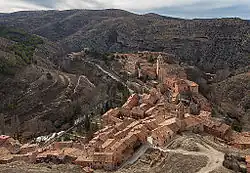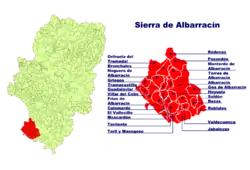Albarracín
Albarracín (Spanish pronunciation: [alβaraˈθin]) is a Spanish town, in the province of Teruel, part of the autonomous community of Aragon. According to the 2007 census (INE), the municipality had a population of 1075 inhabitants. Albarracín is the capital of the mountainous Sierra de Albarracín Comarca.[2]
Albarracín | |
|---|---|
 Albarracín, in a meander of the Guadalaviar River, viewed from Torre del Andador. | |
 Flag .svg.png.webp) Coat of arms | |
 | |
 Albarracín Location in Spain | |
| Coordinates: 40°24′30″N 1°26′22″W | |
| Country | |
| Autonomous community | Aragón |
| Province | Teruel |
| Comarca | Sierra de Albarracín |
| Judicial district | Teruel |
| Government | |
| • Alcalde | Michel Villalta Martín (2019) (PSOE) |
| Area | |
| • Total | 452.72 km2 (174.80 sq mi) |
| Elevation | 1,182 m (3,878 ft) |
| Population (2018)[1] | |
| • Total | 1,016 |
| • Density | 2.2/km2 (5.8/sq mi) |
| Demonyms | Albarracinense, -a Albarriciense, -a Lobetano, -a |
| Time zone | UTC+1 (CET) |
| • Summer (DST) | UTC+2 (CEST) |
| Postal code | 44100 |
| Dialing code | 978 |
| Type | Non-movable |
| Criteria | Historic ensemble |
| Designated | 22 June 1961 |
| Reference no. | RI-53-0000030 |
Albarracín is surrounded by stony hills and the town was declared a Monumento Nacional in 1961.[3] The many red sandstone boulders and cliffs surrounding Albarracín make it a popular rock climbing location, particularly for boulderers.[4][5]
History
The town is named for the Hawwara Berber dynasty of the Banu Razin which was their capital from the early eleventh century until it was taken by the Almoravids in 1104.[6]
From 1167 to 1300, Albarracín was an independent lordship known as the Sinyoría d'Albarrazín which was established after the partition of the Taifa of Albarracín under the control of Pedro Ruiz de Azagra. It was eventually conquered by Peter III of Aragon in 1284, and the ruling family, the House of Azagra was deposed. The last person to actually hold the title of Señor de Albarracín was Juan Núñez I de Lara, although his son, Juan Núñez II de Lara continued on as the pretender to the title until 1300 when the city and its lands were officially incorporated into the Kingdom of Aragon.

Geography
The town is located in a meander of the Guadalaviar River. The Sierra de Albarracín mountain range rises to the South and West of the town.
Demographic growth
| Albarracín demographic trend[7] | |||||||||||||||||||
|---|---|---|---|---|---|---|---|---|---|---|---|---|---|---|---|---|---|---|---|
| 1857 | 1887 | 1900 | 1910 | 1920 | 1930 | 1940 | 1950 | 1960 | 1970 | 1981 | 1991 | 2001 | 2006 | ||||||
| Population | 1,883 | 1,953 | 1,897 | 1,689 | 1,688 | 1,576 | 1,582 | 1,467 | 1,376 | 1,187 | 1,068 | 1,164 | 1,050 | 1,076 | |||||
See also
Gallery
 City walls.
City walls. Typical narrow street in the village.
Typical narrow street in the village. Cathedral.
Cathedral. Square in Albarracín.
Square in Albarracín. Convento of Discalced Carmelites.
Convento of Discalced Carmelites. Pinares de Rodeno Forest near Albarracín.
Pinares de Rodeno Forest near Albarracín.
References
- Municipal Register of Spain 2018. National Statistics Institute.
- Sierra de Albarracín
- "Albarracín, El pueblo más bonito de España". Archived from the original on 2015-05-09. Retrieved 2011-03-12.
- "Albarracín". planetmountain.com. Archived from the original on July 27, 2019.
- "Albarracín". Vertical Climbing. Archived from the original on July 27, 2019. Retrieved July 27, 2019.
- Kennedy, Hugh (2014). Muslim Spain and Portugal: A Political History of Al-Andalus. Routledge. p. 139. ISBN 9781317870418.
- Fuente: Población de hecho según el Instituto Nacional de Estadística de España. Alteraciones de los municipios en los Censos de Población desde 1842, Archived 2009-03-11 at the Wayback Machine Series de población de los municipios de España desde 1996. Archived 2009-08-13 at the Wayback Machine
External links
- Albarracín on Diputación de Teruel (in Spanish)
- Discover Albarracín, a great Mudejar town in Aragón, Spain (in English)